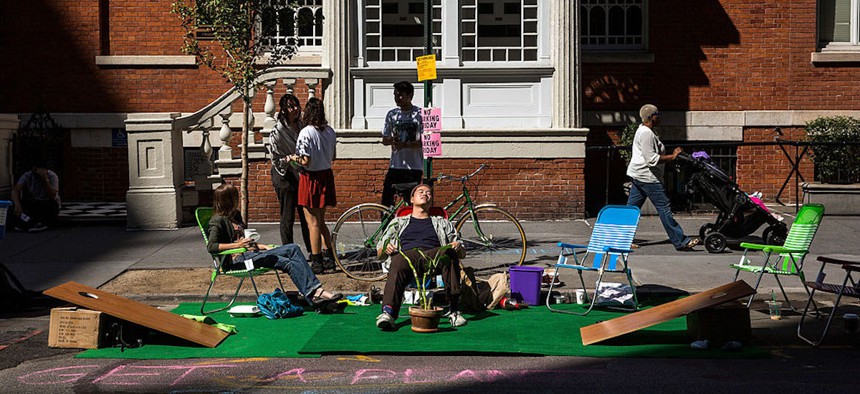Pocket parks emerge as a climate solution

A man relaxes in a lawn chair while participating in Park(ing) Day on Sept. 20, 2013, in New York City. Park(ing) Day is an annual, international day where participants transform ordinary parking spaces into miniature public parks to bring attention to use of space, environment and reliance on cars. Photo by Andrew Burton/Getty Images
Size doesn’t always matter. Even the smallest of green spaces can play a key role in mitigating climate impacts like extreme heat and poor air quality.
Sept. 15 marks the 17th annual Park(ing) Day, a global event where people transform curb lane parking spots into tiny parks and social spaces. The temporary green space allows participants and residents to advocate for safer, greener or more accessible streets.
Setting up a temporary park on a busy street for even one day will certainly make a statement, but pocket parks offer a more realistic alternative. The patches of green nested within giant concrete jungles are usually smaller than an acre and easily accessible to residents.
“The real defining characteristic is that … [pocket parks] provide green space access for folks that may not have it otherwise,” said Dylan McDowell, executive director of the National Caucus of Environmental Legislators, or NCEL.
Plus, for governments with limited resources and competing interests looking for climate change mitigation strategies, “nature-based solutions often cost less than traditional infrastructure,” according to a recent NCEL report. They can also improve disaster resilience, create green jobs and boost property values, economic growth, greenspace equity and public health.
Salt Lake City is one community exploring the potential of pocket parks. Earlier this summer, the city built a temporary pocket park in its downtown to gauge residents’ interest in green spaces. The block-long plaza adorned with 190 trees included a badminton court, space for food trucks and even a small stage for concerts. The park replaced two traffic lanes, but regular traffic was still able to use the street’s outer lanes.
The park was part of a larger Green Loop project to establish a 5.5-mile network of green spaces integrated with city streets. Ultimately, the project aimed to offer residents “an urban forest providing shade, landscaped areas to receive stormwater, a habitat for birds and pollinators and green corridors to safely walk and bike,” senior landscape architect and project manager of Salt Lake City Engineering Nancy Monteith said in an email.
While the park was only open from May until June 11, a community survey showed that more than 60% of respondents would like to see more trees, green spaces and pedestrian-only areas in the city, Monteith said. Respondents also reported that they would like the park to include features that reduce air and noise pollution and attract wildlife. The survey results echo research that shows people’s interest in climate solutions can increase when they can spend more time outdoors.
“By providing more urban … ‘backyards’ for our residents,” Monteith said, Salt Lake City becomes “a more comfortable and inviting place to live, work and visit.”
Other cities are investigating pocket parks as well. Earlier this week, a new pocket park recently opened in Howell, Michigan, for nearby residents who would otherwise have to drive to an outdoor space.
In Texas, San Antonio debuted its Poet’s Point park in June, a stretch of land about a third of an acre big. A stone bench in the park features poems and artwork from local artists to spur community engagement and connection, Texas Public Radio reported.
Last month, Louisville, Kentucky, created a pocket park from an abandoned lot. The park includes a play area, a pollinator garden and a spot for students at a nearby elementary school to enjoy an outdoor class.
“Not everything has to be giant,” McDowell said. “Even just some amount of green space has huge benefits for [climate] and physical health.”






